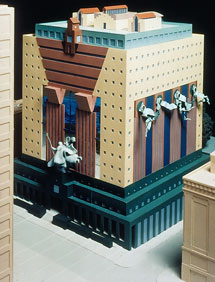May 26, 2011 7:23 AM from Architecture Here and There by David Brussat
The photograph above shows the office of McKim, Mead & White in 1892, celebrating its victory in a competition to design the Rhode Island State House. The firm was on top of its profession in America, and rarely deigned to participate in competitions. In the case of the job in Providence, victory came through the sort of social connections set forth in Mosette Broderick's exhaustive, if not quite exhausting, 581-page book
Triumvirate: McKim, Mead & White, published last year about the architects Charles Follen McKim, William Mead and Stanford White.
Charles Follen McKim, William Rutherford Mead and Stanford White
Stanford White's sketch of Henry Hobson Richardson's Watts-Sherman House, in Newport
Norman precedent for McKim Mead & White's early work
Isaac Bell House, in Newport
Newport Casino
Boston Public Library
Library and Hall of Fame at New York University
Pennsylvania Station, in New York
"When the office won the competition for the Rhode Island State Capitol," writes Broderick, "the draftsmen decided to celebrate with a high-spirited parade led by a bevy of office men who would later be stars of the profession [in their own careers. Frank Hoppin (of Hoppin & Koen), John Mead Howells (William R. Mead's nephew) and Henry Bacon dressed up as High Commissioners of Architecture performing an architectural Mass. Hoppin played pope wearing a mitre and holding a T square as a substitute for a crosier. The acolytes followed swinging an old Venetian lamp as if incense. (Passage omitted from quote to save space.)] Henry Bacon carried a cutout of the winning design while the office sang a hymn to the tune of
'Onward Christian Soldiers':
"Onward, All ye Draughtsmen,
Marching as to War,
With our office T. Square
Going on before.
We are not divided
All our office, we,
In all competitions,
Ours the Victory . . .
Foes may struggle vainly,
We will Vanquish all,
For they are not in it,
They will have to crawl.
Providence is with us
Thro' the darkest night;
In our blest profession
We're simply out of sight."
That passage is almost all there is about one of the firm's major works, cited but twice in the index, as "Rhode Island State Capitol, [page] 304" and "Rhode Island State House, [page] 407." [The latter mentions the project in passing.]
So, yes, a little local pique slightly affects my assessment of Triumvirate. The Ocean State capitol offered Broderick a tasty nugget: winning a commission by social connections even in a competition, in this case perhaps scandalously so. She did not bite. Too bad. Still, by the time of McKim's death, in 1909, the firm had some 940 buildings under its belt. Triage, however inexplicably achieved, was mandatory.
The book has been praised for its social tapestry and criticized for going overboard in detailing that tapestry, and also for lapses in the quality of its prose and the paucity of quotation from primary sources, and for many vague references (mostly free of sniggering) to the sexual bent of its subjects. My big problem with the book is its prejudice against the neoclassicism responsible for much of the firm's fame.
Broderick observes repeatedly that the firm relied heavily on precedent. She rarely manages to avoid looking down her nose at the architects for this supposed infraction.
Broderick puts the blame on Joseph Wells, an architect at the firm whom she nevertheless considers the office's chief genius: "He taught the partners how to find precedent in the volumes of Letarouilly and others in their growing library -- and by showing them that the pages of books contained all the answers, he removed their life force. By the end of the century, everything came out of books.
This unwarranted sneer hints at an important subsidiary bias in Broderick's assessment. The "copying" done for the firm's earlier, Shingle Style work based on the quaint vernacular styles of England and Normandy -- rambling masses of gabled roofs, turrets, porches -- is tut-tutted with less severity by Broderick until the firm embraces neoclassicism. She seems dismayed that, as the importance of their commissions increased, the architects adopted an increasingly lofty architectural vocabulary.
A lot of the book is set in Newport. The Isaac Bell House (1883) and Rosecliff (1902) are representative of the firm's earlier and later work. Broderick's ill-concealed contempt for the latter mars her book's scholarship.
Notwithstanding my regrets, Triumvirate is a monumentally fascinating catalogue of how money and social intercourse dressed the Gilded Age in beauty. We may sigh at the evaporation of the past -- so many of the buildings of McKim, Mead & White razed! But many remain to be studied for inspiration today, and we must be mindful that, however rich America was then, now, despite its current travails, it is far, far and away richer, in almost all respects except for its appreciation of beauty -- a need that architecture could easily supply.
David Brussat (dbrussat@projo.com) is a member of The Journal's editorial board. His blog at projo.com is called Architecture Here and There.


 Reconsidering Postmodernism will gather leading scholars, practitioners, and critics for a rigorous round of lectures, film tributes, and panel discussions. The fully scheduled two-day conference coincides with the 30th anniversary of Tom Wolfe’s seminal publication From Bauhaus to Our House and the themes of the conference—historic significance, impact on design education and public taste, lessons learned and lessons rejected, theoretical underpinnings, and contemporary appraisal—all attempt to illuminate postmodernism’s overall cultural impact.
Reconsidering Postmodernism will gather leading scholars, practitioners, and critics for a rigorous round of lectures, film tributes, and panel discussions. The fully scheduled two-day conference coincides with the 30th anniversary of Tom Wolfe’s seminal publication From Bauhaus to Our House and the themes of the conference—historic significance, impact on design education and public taste, lessons learned and lessons rejected, theoretical underpinnings, and contemporary appraisal—all attempt to illuminate postmodernism’s overall cultural impact.
